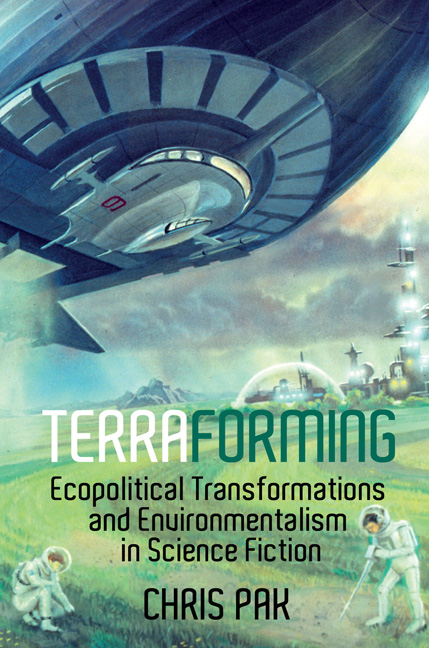Book contents
- Frontmatter
- Dedication
- Contents
- Acknowledgements
- Introduction: Terraforming: Engineering Imaginary Environments
- 1 Landscaping Nature's Otherness in Pre-1960s Terraforming and Proto-Gaian Stories
- 2 The American Pastoral and the Conquest of Space
- 3 Ecology and Environmental Awareness in 1960s–1970s Terraforming Stories
- 4 Edging Towards an Eco-cosmopolitan Vision
- 5 Kim Stanley Robinson's Mars Trilogy
- Conclusion
- Works Cited
- Index
Introduction: Terraforming: Engineering Imaginary Environments
- Frontmatter
- Dedication
- Contents
- Acknowledgements
- Introduction: Terraforming: Engineering Imaginary Environments
- 1 Landscaping Nature's Otherness in Pre-1960s Terraforming and Proto-Gaian Stories
- 2 The American Pastoral and the Conquest of Space
- 3 Ecology and Environmental Awareness in 1960s–1970s Terraforming Stories
- 4 Edging Towards an Eco-cosmopolitan Vision
- 5 Kim Stanley Robinson's Mars Trilogy
- Conclusion
- Works Cited
- Index
Summary
Science-fictional (sf) stories of planetary adaptation – terraforming – construct imaginative spaces to explore society's orientation to ecological, environmental, and geopolitical issues and concerns. Terraforming involves processes aimed at adapting the environmental parameters of alien planets for habitation by Earthbound life, and it includes methods for modifying a planet's climate, atmosphere, topology, and ecology. Combining the Latin terra for ‘earth’ or ‘land’ with the gerund ‘forming,’ the term refers to ‘[t]he process of transforming a planet into one sufficiently similar to the earth to support terrestrial life’ and is chiefly associated with sf discourse (‘Terraforming, n.,’ 2015). While the Online OED credits the first use of the term to Jack Williamson (writing as Will Stewart) in 1949, Jeffrey Prucher traces the verb ‘terraform’ to Williamson's 1942 short story ‘Collision Orbit’ (2007, 235). To a primary definition similar to the Online OED's, Prucher adds two others: ‘to modify a world's environment so that it can support life that evolved on a planet other than the Earth’ (dated to 1969) and ‘to modify the Earth's environment’ (dated to 1997) (235).
These definitions encompass three modes of terraforming. The first designates the human colonisation of space where alien planets are shaped in the image of Earth. The second involves an alien colonisation of space and the alteration of planets to resemble the aliens’ homeworlds. The third, the alteration of Earth's landscape, is at first glance puzzling when paired with the Online OED's primary definition: what does it mean to alter Earth to make it more closely resemble itself? Martyn Fogg helpfully defines terraforming alien planets and terraforming Earth, or ‘geoengineering,’ as two subsets of ‘planetary engineering,’ arguing that ‘phrases such as “terraforming the Earth” have a ring of nonsense about them – how does one make the Earth more like itself?’ (1995, 90). He explains that ‘[g]eoengineering is planetary engineering applied specifically to the Earth. It includes only those macroengineering concepts that deal with the alteration of some global parameter, such as the greenhouse effect, atmospheric composition, insolation or impact flux’ (90).
Prucher's primary definition offers a clue to this conundrum: ‘to modify a world's environment so that it can support Earth life-forms, especially humans’ (2007, 235).
- Type
- Chapter
- Information
- Publisher: Liverpool University PressPrint publication year: 2016



